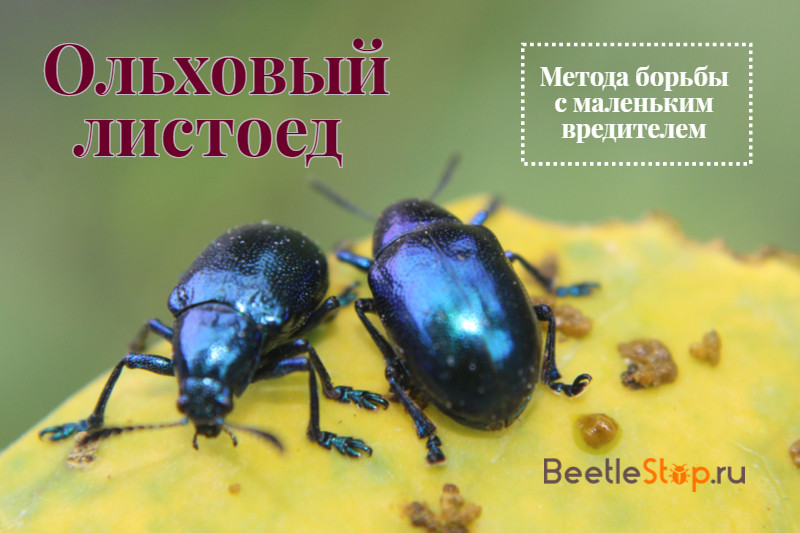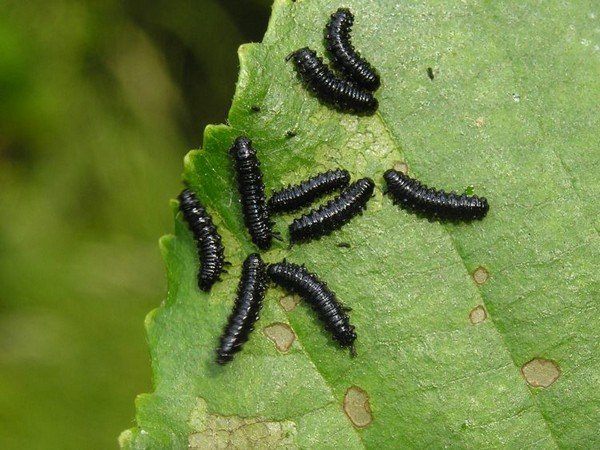Alder leaf beetle - how to save parks from a pest
Leaf beetles are a large family of beetles that have spread throughout. Adults and larvae feed on the leaves of various plants. Many species are pests of agriculture and forests. Alder leaf beetle is an olifagus beetle, its diet is limited to various types of alder. With a lack of food goes to willow, birch, hazelnuts. Mass reproduction of the pest threatens the death of young trees grown in nurseries.

View description
Alder leaf beetle (Agelasticaaini) belongs to the subfamily of gnats from the leaf beetle family. Small beetle - 6-7 mm. Coloring is dark blue, with a violet shade and metal shine. The head is black, the antennae are filiform, reaching half the body. The eyes are large, oval. The width of the chest shield is 2 times its length. Pronotum with distinct angles, lateral parts rounded. The underside of the body is black.
Information. Sexual dimorphism manifests itself in the size of adults - males are smaller than females. Females are easily distinguished by a bright yellow abdomen, peeking from under the elytra.
Convex elytra covered with small dots. Hind wings membranous, transparent, darkened. Beetles are able to fly, but use this quality inactive. They often rise to the leaves, crawling along the trunk of a tree. The limbs are black, the legs are walking, on the lower leg there is one large spur.
Distribution area
The species Agelasticaaini is found wherever an alder feed plant grows. Beetles live in Europe, Kazakhstan, Japan. An alder leaf beetle was introduced to North America. It is found in Russia in the European part, excluding the tundra region, in Siberia, Primorye, and the foothills of the Caucasus.
Lifestyle
The beetle years begin in May. Their habitats are sunny areas of deciduous forests growing near marshes, on the banks of rivers and streams. Adults feed on the leaves of black and gray alder, goat willow, fluffy birch, and some types of plums. Alder leaf beetle is considered one of the most dangerous pests of hazelnut plantations. Insects eat leaves and wild hazel. Beetles gnaw through through holes in them. Hundreds of insects live on one tree, causing enormous damage to the plant. Two generations of beetles are developing during the year: the first - overwintered is observed in April-May, the second - July-August. Second generation adults remain in the soil for wintering.

Features of reproduction and development of beetles
In the spring, after 1-2 weeks of additional nutrition with green leaves, leaf beetles begin to mate. Oblong, orange eggs are attached in heaps of 50-70 pieces to the underside of the gray alder. The breeding period stretches for 5-6 weeks. During this time, the female manages to lay 500-600 eggs.

Information. Fertilized females significantly increase the abdomen. It prevents the elytra from closing, they remain ajar.
After 5-12 days, larvae appear. At the first age they are yellow-green. The body is flat, oblong, widened in the front. The head, scutellum and limbs are black. There are 3 pairs of chest legs. After three links, the larvae turn black with a blue tint. Their body is covered with hairs. Length 12 mm.Larvae keep in groups, feeding on skeletonize leaves of a fodder plant. Adults crawl one by one. Due to the stretched phase of the ovipositor, larvae of different ages can be found simultaneously on alder.

In July, the larvae finish feeding and descend from the trees. In the soil they build an oval cradle in which they pupate. Pupa free, yellow, soft. Its length is 5 mm. A week later, young beetles crawl out of the soil. They feed on leaves until the end of August, then prepare for winter diapause. Adults hibernate, buried in soil or leaf litter at the foot of fodder trees.
Methods of struggle
In order to prevent outbreaks of mass reproduction of insects in forests and nurseries, reconnaissance and detailed surveillance is carried out. Observations are conducted in May-June. The degree of damage to the alder is determined. There are several ways to deal with bugs:
- To prevent the spread of leaf beetles allow forestry activities. It is recommended to create mixed, evenly closed stands.
- To combat the leaf beetle, insecticides of contact action are used. Processing of trees is carried out during the period of feeding of the larvae - in April-May and July. The use of Karbofos and Rogor is recommended.
- Biological measures involve the attraction of insectivorous birds using feeders. Also, parasites and pathogenic fungi are used to destroy beetles.
- In mid-summer, when pupation of leaf beetles occurs in the soil, it is recommended to dig the earth.
An integrated approach to the fight against alder leaf beetle will help protect decorative plantings from pests.

